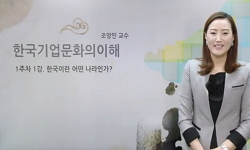Objectives. Experimental models are of importance to study the pathogenesis of middle ear cholesteatoma, however, they were not established until now. We aimed to develop in vitro model of middle ear cholesteatoma using primary keratinocytes and fibro...
http://chineseinput.net/에서 pinyin(병음)방식으로 중국어를 변환할 수 있습니다.
변환된 중국어를 복사하여 사용하시면 됩니다.
- 中文 을 입력하시려면 zhongwen을 입력하시고 space를누르시면됩니다.
- 北京 을 입력하시려면 beijing을 입력하시고 space를 누르시면 됩니다.
https://www.riss.kr/link?id=A101596858
-
저자
Alexander M. Raynov, (University Hospital Tzaritza Joanna, Medical University - Sofia, Sofia, Bulgaria) ; 정연훈 (아주대학교) ; 박헌이 (아주대학교) ; 최성준 (건양대학교) ; 박기현 (아주대학교)
- 발행기관
- 학술지명
- 권호사항
-
발행연도
2008
-
작성언어
English
- 주제어
-
자료형태
학술저널
-
수록면
86-91(6쪽)
-
KCI 피인용횟수
13
- 제공처
-
0
상세조회 -
0
다운로드
부가정보
다국어 초록 (Multilingual Abstract)
Objectives. Experimental models are of importance to study the pathogenesis of middle ear cholesteatoma, however, they
were not established until now. We aimed to develop in vitro model of middle ear cholesteatoma using primary
keratinocytes and fibroblasts isolated from cholesteatoma tissue. HaCaT cell line was used as a “skin equivalent”
and to compare the grade of homogeneity between cholesteatoma keratinocytes and HaCaT cells.
Methods. Primary keratinocytes were isolated from cholesteatoma tissue, co-cultured with preliminary prepared feeder
layer from cholesteatoma fibroblasts and subsequently air-exposed. The protein profile of cholesteatoma keratinocytes
and HaCaT cells was evaluated by means of immunoblot using monoclonal antibody against cytokeratin (CK) 13
and 16. Tissue localization of CK 13 and 16 was accomplished with immunohistochemistry.
Results. Different protein profile and stronger expression of CK 13 and 16 were demonstrated in cholesteatoma keratinocytes
in comparison with HaCaT cells. Bigger stratification was observed in the 3D-in vitro systems when both cholesteatoma
keratinocytes and HaCaT cells were respectively co-cultured with fibroblasts in comparison with the corresponding
control groups without fibroblasts.
Conclusion. 3D-model demonstrates the significance of intercellular interaction between components of cholesteatoma
tissue.
다국어 초록 (Multilingual Abstract)
Objectives. Experimental models are of importance to study the pathogenesis of middle ear cholesteatoma, however, they were not established until now. We aimed to develop in vitro model of middle ear cholesteatoma using primary keratinocytes and fib...
Objectives. Experimental models are of importance to study the pathogenesis of middle ear cholesteatoma, however, they
were not established until now. We aimed to develop in vitro model of middle ear cholesteatoma using primary
keratinocytes and fibroblasts isolated from cholesteatoma tissue. HaCaT cell line was used as a “skin equivalent”
and to compare the grade of homogeneity between cholesteatoma keratinocytes and HaCaT cells.
Methods. Primary keratinocytes were isolated from cholesteatoma tissue, co-cultured with preliminary prepared feeder
layer from cholesteatoma fibroblasts and subsequently air-exposed. The protein profile of cholesteatoma keratinocytes
and HaCaT cells was evaluated by means of immunoblot using monoclonal antibody against cytokeratin (CK) 13
and 16. Tissue localization of CK 13 and 16 was accomplished with immunohistochemistry.
Results. Different protein profile and stronger expression of CK 13 and 16 were demonstrated in cholesteatoma keratinocytes
in comparison with HaCaT cells. Bigger stratification was observed in the 3D-in vitro systems when both cholesteatoma
keratinocytes and HaCaT cells were respectively co-cultured with fibroblasts in comparison with the corresponding
control groups without fibroblasts.
Conclusion. 3D-model demonstrates the significance of intercellular interaction between components of cholesteatoma
tissue.
참고문헌 (Reference)
1 Proops DW, "Tissue culture of human cholesteatomatous keratinocytes" 8 (8): 165-170, 1983
2 Sade J, "The metaplastic and congenital origin of cholesteatoma" 96 (96): 119-129, 1983
3 Gray JD, "The chronic ear: the treatment of cholesteatoma in children" 57 : 769-771, 1964
4 Kuijpers W, "Squamous metaplasia of the middle ear epithelium" 116 (116): 293-298, 1996
5 Tanaka Y, "Roles of cytokines and cell cycle regulating substances in proliferation of cholesteatoma epithelium" 109 (109): 1102-1107, 1999
6 Boelsma E, "Reconstruction of a human skin equivalent using a spontaneously transformed keratinocyte cell line (HaCaT)" 112 (112): 489-498, 1999
7 Vassalli L, "Propylene glycolinduced cholesteatoma in chinchilla middle ears" 9 (9): 180-188, 1988
8 Cheshire IM, "Production of parathyroid-hormone-related protein by cholesteatoma cells in culture" 338 (338): 1041-1043, 1991
9 Schulz P, "Possible autocrine growth stimulation of cholesteatoma epithelium by transforming growth factor alpha" 14 (14): 82-87, 1993
10 Boukamp P, "Normal keratinization in a spontaneously immortalized aneuploid human keratinocyte cell line" 106 (106): 761-771, 1988
1 Proops DW, "Tissue culture of human cholesteatomatous keratinocytes" 8 (8): 165-170, 1983
2 Sade J, "The metaplastic and congenital origin of cholesteatoma" 96 (96): 119-129, 1983
3 Gray JD, "The chronic ear: the treatment of cholesteatoma in children" 57 : 769-771, 1964
4 Kuijpers W, "Squamous metaplasia of the middle ear epithelium" 116 (116): 293-298, 1996
5 Tanaka Y, "Roles of cytokines and cell cycle regulating substances in proliferation of cholesteatoma epithelium" 109 (109): 1102-1107, 1999
6 Boelsma E, "Reconstruction of a human skin equivalent using a spontaneously transformed keratinocyte cell line (HaCaT)" 112 (112): 489-498, 1999
7 Vassalli L, "Propylene glycolinduced cholesteatoma in chinchilla middle ears" 9 (9): 180-188, 1988
8 Cheshire IM, "Production of parathyroid-hormone-related protein by cholesteatoma cells in culture" 338 (338): 1041-1043, 1991
9 Schulz P, "Possible autocrine growth stimulation of cholesteatoma epithelium by transforming growth factor alpha" 14 (14): 82-87, 1993
10 Boukamp P, "Normal keratinization in a spontaneously immortalized aneuploid human keratinocyte cell line" 106 (106): 761-771, 1988
11 Lang S, "Localization of transforming growth factor-beta-expressing cells and comparison with major extracellular components in aural cholesteatoma" 106 (106): 669-673, 1997
12 Park K, "Immunohistochemical study of cytokeratin expression in experimental cholesteatoma, Recent advances in otitis media, Sixth International Symposium" Decker Inc. 275-277, 1996
13 Ergun S, "Expression of transforming growth factor-alpha and epidermal growth factor receptor in middle ear cholesteatoma" 17 (17): 393-396, 1996
14 Sasaki H, "Expression of cytokeratins 13 and 16 in middle ear cholesteatoma" 110 (110): 310-317, 1994
15 Park K, "Experimental cholesteatoma by transplanting a free skin graft in the bulla of Mongolian gerbil" 39 (39): 1138-1143, 1996
16 Choufani G, "Determination of the levels of expression of sarcolectin and calcyclin and of the percentages of apoptotic but not proliferating cells to enable distinction between recurrent and nonrecurrent cholesteatomas" 109 (109): 1825-1831, 1999
17 Huang T, "Colony-stimulating factor in middle ear cholesteatoma" 10 (10): 393-398, 1989
18 McGinn MD, "Cholesteatoma. Experimental induction in the Mongolian Gerbil, Meriones Unguiculaus" 93 (93): 61-67, 1982
19 Cheshire IM, "An in vitro growth study on cholesteatoma and normal skin" 20 (20): 453-460, 1995
20 Albers-op t’ Hof BM, "Air-exposed tissue culture of human middle ear epithelium and meatal epidermis: a method to study the advancing front of cholesteatoma" 122 (122): 720-725, 2002
동일학술지(권/호) 다른 논문
-
Chemocauterization of Congenital Fistula from the Accessory Parotid Gland
- 대한이비인후과학회
- 하정훈
- 2008
-
- 대한이비인후과학회
- 유민욱
- 2008
-
- 대한이비인후과학회
- 노종렬
- 2008
-
- 대한이비인후과학회
- 송달원
- 2008
분석정보
인용정보 인용지수 설명보기
학술지 이력
| 연월일 | 이력구분 | 이력상세 | 등재구분 |
|---|---|---|---|
| 학술지등록 | 한글명 : Clinical and Experimental Otorhinolaryngology외국어명 : Clinical and Experimental Otorhinolaryngology | ||
| 2023 | 평가예정 | 해외DB학술지평가 신청대상 (해외등재 학술지 평가) | |
| 2020-01-01 | 평가 | 등재학술지 유지 (해외등재 학술지 평가) |  |
| 2013-10-01 | 평가 | 등재학술지 선정 (기타) |  |
| 2012-01-01 | 평가 | 등재후보학술지 유지 (기타) |  |
| 2011-01-01 | 평가 | 등재후보 1차 PASS (등재후보1차) |  |
| 2009-01-01 | 평가 | 등재후보학술지 선정 (신규평가) |  |
| 2007-06-14 | 학회명변경 | 영문명 : Korean Society Of Otolaryngology -> Korean Society of Otorhinolaryngology-Head and Neck Surgery |
학술지 인용정보
| 기준연도 | WOS-KCI 통합IF(2년) | KCIF(2년) | KCIF(3년) |
|---|---|---|---|
| 2016 | 1.14 | 0.1 | 0.84 |
| KCIF(4년) | KCIF(5년) | 중심성지수(3년) | 즉시성지수 |
| 0.71 | 0.6 | 0.324 | 0 |




 ScienceON
ScienceON






